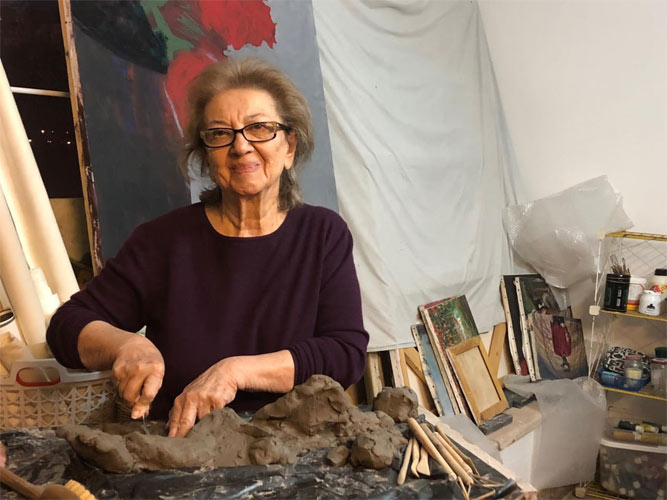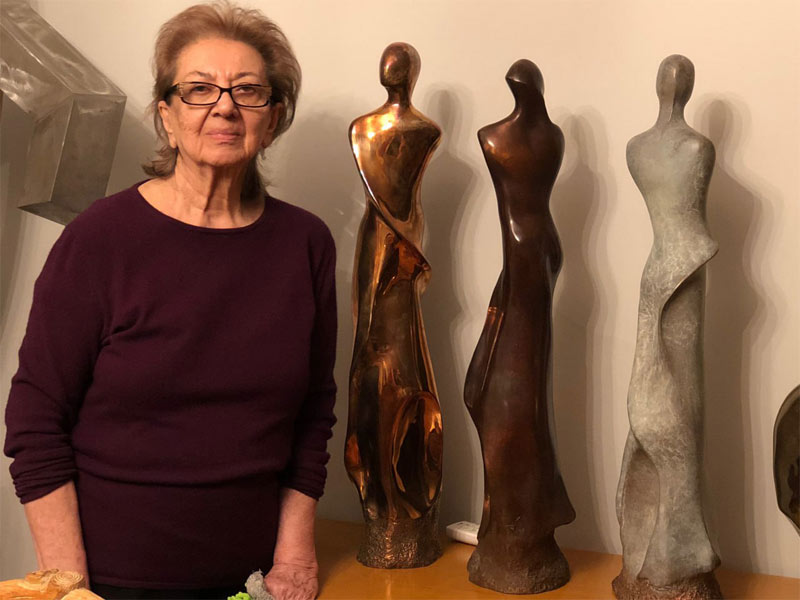
BIOGRAPHY OF GUITY SEIF
Guity Seif was born in February 1937 in Tehran, and from an early age was exposed to classical Persian and contemporary European art, taking inspiration from her father and uncle’s substantial antique, carpet and painting collection. She began to take lessons in painting at the early age of nine, and later learned to refine her technique under the guidance of a Russian teacher she met whilst at school and from whom she learnt the basic principles of classical painting.
She soon began to experiment with oil painting, applying colors directly onto the canvas and mixing them with a paintbrush. She applied this challenging technique consistently in her work in order to achieve the desired result, and soon the process of mixing and realizing the required complex color combination became second nature to her.
For many years thereafter she painted infrequently until she moved to France with her husband and son in 1978, where she frequented the many museums, galleries, international exhibitions in Paris. She attended different classes where she took up different painting styles and techniques, and began to paint again in a different perspective from her earlier work. She participated in group and individual exhibitions with large paintings in Paris and other cities in France and was awarded medals as well as honorary diplomas. This recognition encouraged her to continue her work and explore different styles, including abstract impressionism and modern renditions of faces and figures.
She came to working with sculpture somewhat unintentionally. In 1983, on the recommendation of an Italian artist residing in France, she began working in a private workshop in Paris. As her work in sculpture evolved and she made and sold more sculptures, she was referred to the Landowski Foundry in the small town of Bagnolet outside of Paris; a foundry repudiated for its rich history and for being a venue where sculptors to work and exhibit. Under the tutelage of Master Didier Landowski she became familiar with the subtle and complex techniques and processes involved in sculpting. There she met and learnt from other sculptors like Igor Ustinov and bronze making experts. This led to her early work making plaster sculptures evolve into experimenting with bronze which eventually became the dominant style of her sculpted works. Her biggest bronze status, “La Decadence”, measures 2.3 x 1.0 x 1.0 meters.
She has exhibited in both solo and group shows in Iran, Europe, Asia and the United States. Her awards and recognitions include: gold medal rosette at the 1987 Solidarite Culturelle Francaise award; bronze medal at the associated art competition at the 1987 Deauville International Cinema Festival; bronze medal awarded at the Associated Art Competition in 1988; first prize at the Vittel International Painting and Sculpture Competition; bronze medal at the 1986 Ida Wingerter Painting and Sculpture Competition; silver medal with rosette at the 1987 Cultural French Solidarity competition; and featured in the 2003 permanent collection for the Fine Arts Museum in Kyrgyzstan.
Her works of painting and sculpture can be largely characterized as impressionist and expressionist. She hopes to continue her artistic practices as long as she is able to see color and feel the warmth of sculpting plaster in her hands.

